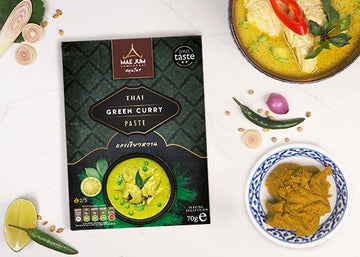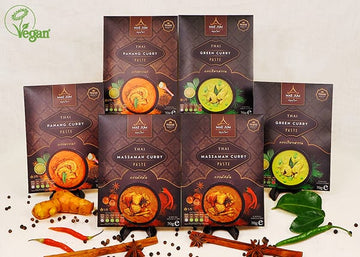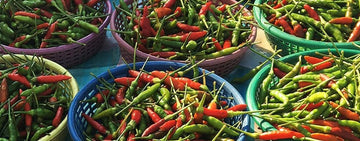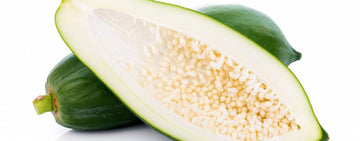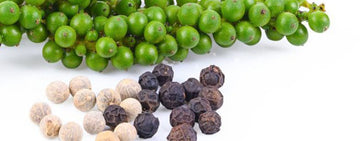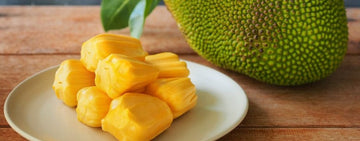Get to Know: Red and Green Chillies – A Deep Dive into Thai Chilli Peppers
Thai food is celebrated for its bold, vibrant flavours, with one of its most defining characteristics being the heat of its fresh chilli peppers. Red and green Thai chillies bring an unmistakable kick to the cuisine, delivering both intense flavour and numerous health benefits. Whether used in curries, stir-fries, or sauces, these chillies add a fiery element that has become synonymous with Thai cooking. Beyond their culinary role, Thai chillies are known for their medicinal properties, making them a valuable addition to any diet.
In this blog, we’ll explore everything you need to know about red and green Thai chillies, from their varieties and uses in cooking to their impressive health benefits.
Thai Chillies: A Diverse Family of Heat
Contrary to popular belief, there isn’t a single variety of “Thai chilli pepper.” In fact, there are at least 79 distinct varieties of chilli that originate from three species native to Thailand. While these chillies may vary in size, shape, and colour, they share one common trait: their fiery heat. Small in size but high in pungency, Thai chillies are essential to the intense flavour profile of Thai cuisine.
The names of chilli peppers are often debated, and this is especially true with Thai chillies. For instance, 'prik num', or "banana peppers," closely resemble New Mexican peppers and are also grown in Kashmir, India, where they’re known as Kashmir peppers. This adds to the confusion when discussing Thai chillies, but regardless of the name, the heat and flavour they provide are undeniable.
The Chilli Pepper Plant
Chilli peppers, including Thai varieties, are the fruit of plants belonging to the nightshade family (Solanaceae), which also includes tomatoes, aubergines, and potatoes. Scientifically, chilli peppers are known as Capsicum annuum. These plants produce fruit pods that vary in size, shape, colour, and, most importantly, heat. The spiciness of chilli peppers is measured in Scoville Heat Units (SHU), a scale that ranks peppers based on their capsaicin content (the chemical responsible for their heat).
- Sweet bell peppers rank at 0 SHU, offering no heat.
- Jalapeño peppers fall between 2,500 and 4,000 SHU.
- Mexican habaneros are much hotter, ranging from 200,000 to 500,000 SHU.
Thai chillies, known for their heat, typically fall between 50,000 and 100,000 SHU, depending on the variety. Inside the chilli pod, numerous tiny, white or cream-coloured seeds are attached to the central placenta, which contains the highest concentration of capsaicin.

Red vs Green Thai Chillies
Red and green Thai chillies come from the same plant, but their difference lies in their ripeness. Green chillies are harvested earlier, while red chillies are left to ripen fully on the plant. This difference in ripeness results in subtle variations in flavour and heat.
- Green Thai Chillies: These chillies tend to have a sharper, more herbaceous flavour. Their heat is immediate and bold, making them perfect for quick-cooking dishes like stir-fries.
- Red Thai Chillies: Red chillies are slightly sweeter and have a more rounded, mature flavour. Their heat builds more slowly and lasts longer on the palate, which makes them ideal for curries and slow-cooked dishes.
Both types of chillies are versatile and can be used fresh, dried, or ground into a powder. In Thai cooking, they are often combined to create a balance of sharp, bright heat from the green chillies and deep, lingering warmth from the red ones.
How Thai Chillies Are Used in Cooking
Thai chillies are a cornerstone of Thai cuisine, where they add heat, colour, and flavour to a variety of dishes. Whether they’re used fresh or dried, whole or ground, Thai chillies are incredibly versatile.
1. In Curry Pastes
One of the most common uses of Thai chillies is in the preparation of curry pastes. Both red and green chillies are ground with other aromatic ingredients like garlic, lemongrass, and galangal to create pastes that serve as the base for Thai curries. Red chillies are typically used in Red Curry, while green chillies are the star of Green Curry. These pastes deliver a punch of heat and vibrant colour, with the red curries being slightly milder and sweeter, while green curries pack more of an herbaceous punch.
2. In Stir-Fries
In quick-cooking stir-fries, fresh Thai chillies are often sliced thinly and added towards the end of cooking to provide a burst of heat. Dishes like 'Pad Kra Pao' (stir-fried basil and chilli) rely on the immediate, sharp heat of green Thai chillies to complement the savoury, umami flavours of soy sauce and garlic.
3. As Garnishes
Because of their bright red and green colours, Thai chillies are frequently used as a garnish. Sliced or left whole, they add visual appeal to dishes while signalling the heat that’s to come. They are often seen adorning soups like Tom Yum and curries like Panang Curry, where their colour contrasts beautifully with the creamy coconut milk.
4. In Sauces and Dips
Thai chillies are also key ingredients in traditional Thai sauces and dips, such as 'Nam Pla Prik' (fish sauce with chillies). This simple but flavour-packed sauce, made by combining fish sauce, lime juice, and thinly sliced chillies, is served alongside almost every Thai meal, adding an extra layer of heat and seasoning.
Thai chillies are also featured in other Asian cuisines. In Myanmar, for example, they are known as 'nga yut thee' and appear in curries and spicy relishes like 'balachong'. Similarly, Laotian cuisine uses chillies in pastes and stuffed dishes, while in Vietnam, they are added to fish sauces and spicy broths.
Health Benefits of Thai Chillies
Beyond their culinary use, Thai chillies are packed with health-promoting compounds that offer a range of medicinal benefits. The key active component in chillies is capsaicin, which gives them their intense heat. Capsaicin has been the subject of numerous studies, and research suggests that it offers several potential health benefits.
1. Rich in Antioxidants
Thai chillies are loaded with vitamins and antioxidants that help protect the body from oxidative stress and free radicals. The high levels of vitamin C in fresh chillies (240% of the recommended daily allowance per 100g) support immune function and collagen production, helping to maintain healthy skin, blood vessels, and bones. In addition to vitamin C, chillies contain vitamin A, beta-carotene, and other flavonoids like lutein and zeaxanthin, which contribute to overall health and may help reduce the risk of chronic diseases.
2. Anti-Inflammatory and Pain Relief Properties
Capsaicin has been shown to have anti-inflammatory properties, making it beneficial for people suffering from conditions like arthritis. It works by reducing the production of certain neuropeptides that cause inflammation in the body. Capsaicin is also known to act as an analgesic, providing pain relief by depleting substance P, a neurotransmitter responsible for sending pain signals to the brain.
3. Supports Heart Health
Regular consumption of chillies may help support heart health by reducing cholesterol levels and lowering blood pressure. Capsaicin has been found to reduce LDL cholesterol (the "bad" cholesterol) in the body, which can lower the risk of heart disease. Additionally, the high potassium content in chillies helps regulate blood pressure by balancing the body’s fluids and reducing the strain on the cardiovascular system.
4. Aids in Weight Loss
Capsaicin is also known to boost metabolism, helping the body burn more calories and aiding in weight loss. Studies suggest that capsaicin increases thermogenesis, the process by which the body generates heat, which can lead to increased calorie burning. Additionally, capsaicin has been shown to reduce appetite, making it a useful tool for those looking to manage their weight.
5. Boosts Immunity
As a rich source of vitamin C and other antioxidants, Thai chillies help strengthen the immune system, protecting the body from infections and illnesses. Regular consumption of chillies can enhance the body’s ability to fight off colds, flu, and other respiratory infections.

How to Handle and Use Thai Chillies Safely
While Thai chillies can add incredible flavour and heat to your dishes, they should be handled with care due to their high capsaicin content. Here are some tips for using Thai chillies safely:
- Wear Gloves: If you’re working with a large number of chillies, consider wearing gloves to protect your skin from the capsaicin, which can cause irritation.
- Avoid Touching Your Face: Capsaicin can be especially painful if it comes into contact with your eyes or sensitive skin. Always wash your hands thoroughly after handling chillies.
- Remove the Seeds for Less Heat: If you want to reduce the heat in your dish, remove the seeds and inner membrane from the chilli before using it.
Conclusion: The Power of Thai Chillies
Red and green Thai chillies are much more than just sources of heat in Thai cuisine. Their unique flavours and health benefits make them essential ingredients in the kitchen, adding both vibrancy and nutrition to a wide variety of dishes. Whether you’re crafting a fiery curry or adding a spicy garnish to your soup, Thai chillies will elevate your cooking and provide a host of health benefits along the way.
Next time you’re in the kitchen, don’t hesitate to reach for these small but mighty chillies—they’ll bring bold flavours, vibrant colour, and a dose of wellness to your meals.
If you enjoyed reading the secrets of Thai chillies, please give this post a rating and subscribe for new blog updates and recipes. Follow and tag us @maejumsamunprai on social media for great foodie content and giveaway competitions! Read more on our blogs today!
